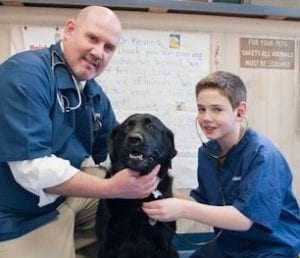By Matthew Kearns, DVM
 Marijuana has now become much more of a mainstay in the United States. Starting in 1937 marijuana was illegal throughout the United States. This lasted until the Compassionate Use Act was passed in California in 1996. There are now eight states (and the District of Columbia) that legally allow the use of recreational marijuana and 20 states that allow the use of medical marijuana.
Marijuana has now become much more of a mainstay in the United States. Starting in 1937 marijuana was illegal throughout the United States. This lasted until the Compassionate Use Act was passed in California in 1996. There are now eight states (and the District of Columbia) that legally allow the use of recreational marijuana and 20 states that allow the use of medical marijuana.
There are also advertisements on the internet that sell a variety of cannabis products for pets that include capsules, oils, butters, tinctures, infused chews and dog treats. Now, before you start asking your veterinarian to become Dr. “Cheech and Chong” or Dr. “Method Man,” I must print this disclaimer: The law does not approve the use of medical marijuana for pets in any of these 50 United States or the District of Columbia.
The chemical substances derived from marijuana products are called cannabinoids. There are actually over 80 cannabinoids derived from the Cannabis plant but, only two are of real importance for our purposes: tetrahydrocannabinol (THC) and cannabidiol (CBD). THC is found in the marijuana plant, while CBD is found in hemp. THC has a psychotropic effect (what gets people “high”) but CBD is the nonpsychotropic compound found primarily in hemp.
What, historically, are the uses of marijuana and hemp? Human studies have shown that marijuana helps with glaucoma, nausea related to chemotherapy, neuropathy (nerve associated pain) and spasticity. There are also anecdotal studies that marijuana products can help with seizures. Both THC-based and CBD-based cannabinoids have an effect on cognition, immunity, inflammation, preventing cell death and cancer, pain, emotional memory, nausea and appetite stimulation. There are studies that state that cannabinoids have potent antibacterial effects against MERSA.
There are (as mentioned above) a large number of these products available without a prescription (many of them hemp based). In order to ship these products without a prescription, they have to contain less than 1 percent of CBD and 0.3 percent of THC. Unfortunately, this has opened the door to some unscrupulous entrepreneurs. Many of the hemp-based products sold on the internet are derived from industrial-grade hemp and only used for fiber.
If one remembers from previous articles on supplements that the supplement industry was able to get Congress to pass the Dietary Supplement Health and Education Act in 1994. This act, in a nutshell, stated that no supplement (human or veterinary) can claim to diagnose, prevent, mitigate, treat or cure a particular disease. However, general claims that link a particular supplement to the prevention of particular diseases are allowed.
There are many benefits to the use of cannabis products. Unfortunately, medical marijuana is unavailable for pets, and “let the buyer beware” when choosing cannabis products. I’ll keep you updated to any changes as I find out.
Dr. Kearns practices veterinary medicine from his Port Jefferson office and is pictured with his son Matthew and his dog Jasmine.



 Aaaah, summer’s here and we know it by the smells in the air. Tantalizing aromas of steak, sausage, chicken, burgers and dogs. After dinner it’s marshmallows (sometimes with graham crackers and chocolate). I don’t know anyone who doesn’t love it (including our pets). As gratifying as it is to have friends and family over, we have to be careful of our “unofficial tasters” hanging around the barbecue.
Aaaah, summer’s here and we know it by the smells in the air. Tantalizing aromas of steak, sausage, chicken, burgers and dogs. After dinner it’s marshmallows (sometimes with graham crackers and chocolate). I don’t know anyone who doesn’t love it (including our pets). As gratifying as it is to have friends and family over, we have to be careful of our “unofficial tasters” hanging around the barbecue.
 The weather is warming up and the days are getting longer. This can only mean one thing: kittens, kittens, kittens and more kittens! All these kittens need homes, but care should be taken in introducing them to your home if you have other cats. The two most common diseases that we worry about before introducing cats to our households are the feline leukemia virus (FeLV) and the feline immunodeficiency virus (FIV).
The weather is warming up and the days are getting longer. This can only mean one thing: kittens, kittens, kittens and more kittens! All these kittens need homes, but care should be taken in introducing them to your home if you have other cats. The two most common diseases that we worry about before introducing cats to our households are the feline leukemia virus (FeLV) and the feline immunodeficiency virus (FIV).
 “My dog ate three grapes (or raisins). Should I be worried?” We get a phone call like this at least once every week to every other week. That’s a good question because we, as a veterinary community, are still looking for the exact answer. Let’s take a closer look at grape and raisin toxicity to see if we can shed some light on what we do know about this nebulous topic.
“My dog ate three grapes (or raisins). Should I be worried?” We get a phone call like this at least once every week to every other week. That’s a good question because we, as a veterinary community, are still looking for the exact answer. Let’s take a closer look at grape and raisin toxicity to see if we can shed some light on what we do know about this nebulous topic. Additional theories do not implicate anything in the grape itself, but rather the growth of certain fungi on the grape and toxins produced called aflatoxins, or pesticides sprayed on grapes. More recent evidence points toward something in the meaty portion of the grape or raisin because veterinary toxicologists found that raisins that have been cooked (in cookies, breads, cakes, etc.) are less toxic than grapes or uncooked raisins.
Additional theories do not implicate anything in the grape itself, but rather the growth of certain fungi on the grape and toxins produced called aflatoxins, or pesticides sprayed on grapes. More recent evidence points toward something in the meaty portion of the grape or raisin because veterinary toxicologists found that raisins that have been cooked (in cookies, breads, cakes, etc.) are less toxic than grapes or uncooked raisins.
 Spring has sprung and as I look at my waistline it is obvious I put on a few extra pounds during the winter months. Fighting obesity is a year-round battle in both people and pets. The questions arise however: Are there factors predisposing pets to obesity? If so, what are they?
Spring has sprung and as I look at my waistline it is obvious I put on a few extra pounds during the winter months. Fighting obesity is a year-round battle in both people and pets. The questions arise however: Are there factors predisposing pets to obesity? If so, what are they? In both cats and dogs the loss of certain hormones associated with the reproductive system will affect metabolism. Through studies it is estimated that the calorie requirements drop by about 25 percent after a spay or neuter.
In both cats and dogs the loss of certain hormones associated with the reproductive system will affect metabolism. Through studies it is estimated that the calorie requirements drop by about 25 percent after a spay or neuter.
 I can’t even recall how many times a feline with a runny nose enters my clinic. A kitten is a little more straightforward as an infection is most likely the cause.But what happens when an adult cat presents? What if this cat is the only cat in the household? What if the cat never goes outside? This is when it gets interesting (and sometimes a touch frustrating).
I can’t even recall how many times a feline with a runny nose enters my clinic. A kitten is a little more straightforward as an infection is most likely the cause.But what happens when an adult cat presents? What if this cat is the only cat in the household? What if the cat never goes outside? This is when it gets interesting (and sometimes a touch frustrating).



